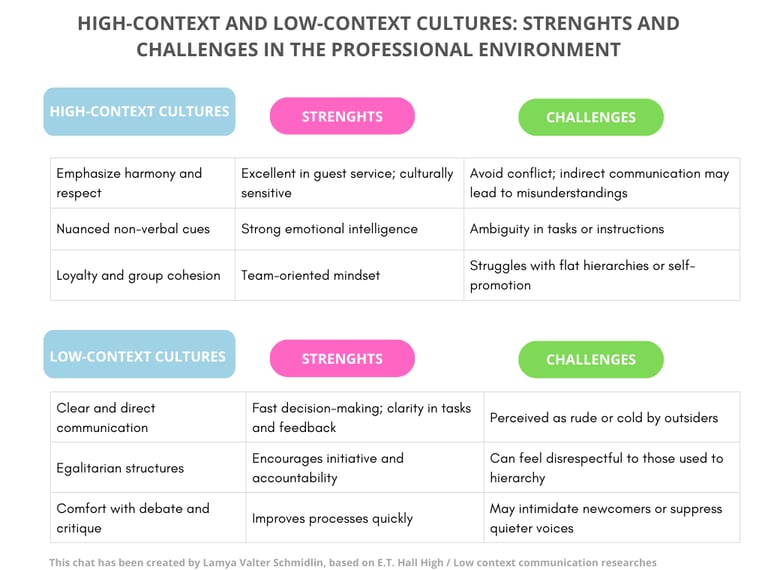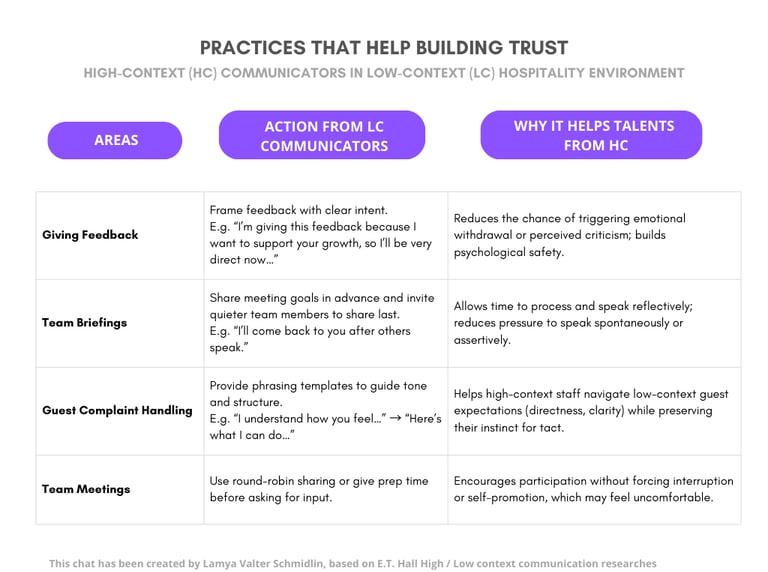The Gift of High-Context Cultural Talents to Low-Context Hospitality Environments
This article explores the impact of high- and low-context communication styles in multicultural hospitality teams. Drawing on Edward T. Hall’s framework, it highlights common communication gaps between international talents and local workplace cultures, particularly in Dutch hotels. Practical tools such as a HR checklist are provided to support the integration of high-context professionals, ensuring their unique strengths are valued. The aim is to foster belonging and enable teams to deliver truly human-centred hospitality across cultures.
INTERCULTURALHUMAN RESSOURCESCROSS-CULTURAL MANAGEMENTHOSPITALITY
Lamya Valter Schmidlin
9/28/20253 min read
In hospitality, where teamwork, guest experience, and service standards rely heavily on smooth communication, cultural differences can quickly lead to friction. One key framework to understand these differences is Edward T. Hall’s concept of high-context vs. low-context communication. This model helps explain why team members from different parts of the world may interpret the same message in entirely different ways.
Edward T. Hall defined high-context cultures like Latin American countries, France or Greece as those where communication relies on shared knowledge, relationships, and non-verbal cues. In these settings, meaning is rarely made explicit as it is felt, inferred, or implied. In contrast, low-context cultures, like the Netherlands, the US or Germany prefer clear, verbal, and unambiguous communication, where the speaker takes full responsibility for clarity.
“In high-context communication, the listener must read between the lines. In low-context cultures, the speaker must leave no room for interpretation.” Erin Meyer.
The Benelux environment
One doesn't have to travel too far to notice these differences, for example, within the Benelux, we already observe this tension between Amsterdam and Brussels.
Dutch workplaces operate on radical clarity, direct feedback, and flat hierarchies
French-speaking Belgium leans more towards formality, relationship-based, and indirect cues
For international talents joining Dutch hotel teams from Latin America, North Africa, or Asia, these shifts can feel like stepping into an entirely different communication universe. Below is a sum up of both communication styles with their strenghts and pitfalls trough an objective lens.


How to support talents from High context communication environments in low-context teams?
When high-context professionals enter a low-context team culture and particularly one as direct and egalitarian as in the Netherlands, their natural strengths (politeness, emotional reading, deference) can be misinterpreted as passivity or vagueness. To ensure talent adaptation and unlock their full potential, support should be brought beyond the onboarding days for a lasting blooming journey.
Pre-arrival & Onboarding: prepare the ground
Failures in talent integration can happen before the first briefing even begins. Cultural expectations need to be translated into behavioral terms to avoid abstract concepts and make sure the talent is aware of the differences. Below are some examples of practical tool to ensure preparing the ground:
Checklist for Human Ressources:
❏ Is this talent used to hierarchical cultures?
❏ Have you explained flat decision-making norms?
❏ Do they understand that “constructive criticism” is a form of support?
Pre-departure culture briefing:
Frame Dutch directness as functional, not personal
Explain that disagreement is not disrespectful in low-context teams
Onboarding handbook excerpt:
Use visual guides showing “what to expect” and “what it looks like” such as:
High-context expectation: “My manager can read my silence as understanding.” // Low-context norm: “Your manager expects you to ask questions if anything is unclear.”
Daily operation: practices that build trust
Low-context communication teams can also help integrating high-context communicator by including micro-practices in their daily operation, such as the examples in the table below:
Peer support structures:
Assigning a “cultural buddy”, ideally someone who has adapted successfully.
Normalizing reflection sessions “What communication style surprised you this week? "What helped you feel understood?”
___
The idea is to help HC talents not fitting in but belonging as individuals and succeed while preserving the strengths of their original style, and giving their teams the tools to appreciate them.
Because when hospitality teams understand not only what is said, but what is meant, they deliver something no SOP can teach: genuine, human-centred hospitality, across cultures. A true gift in every hospitality environments.
___
Below are the references of the books/ Academic articles I have read to write this article:
Meyer, E. (2014). The culture map: Breaking through the invisible boundaries of global business. PublicAffairs.
Hall, E. T. (1976). Beyond culture. Anchor Books.
Thank you very much for reading.
Lamya


LVS *AC
Cross-cultural guest experience research
contact
lamya@lvsacrosscultures.com
+33 782 353 314
© 2024. LVS AC - All rights reserved.
